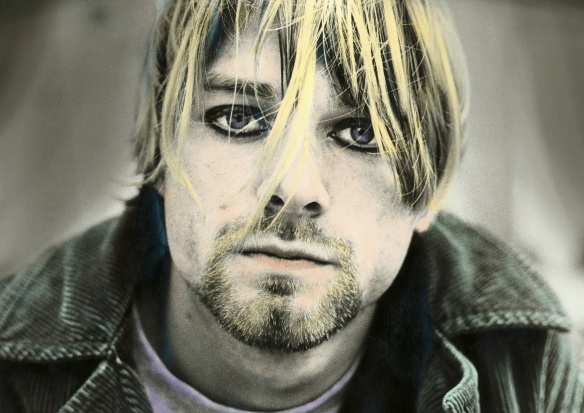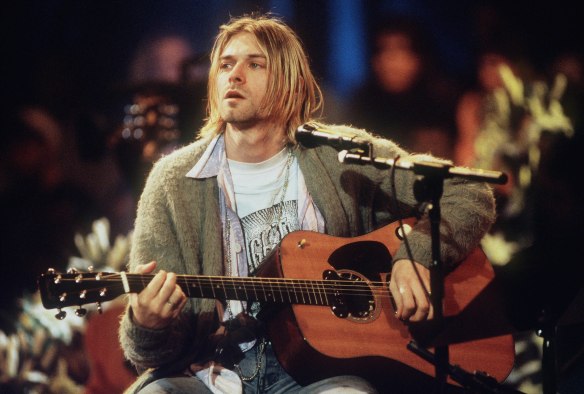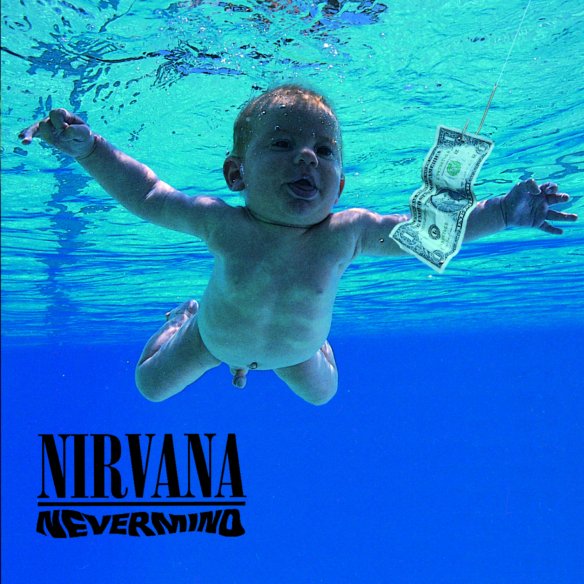« Welcome to Aberdeen. Come as you are ». Le panneau indicateur planté à l’entrée de la ville natale de Kurt Cobain donne le ton, en citant le tube légendaire de Nirvana pour accueillir les fans du défunt empereur du grunge.
Vingt ans après le suicide du chanteur, cette ville passablement délabrée à deux heures de Seattle (nord-ouest des Etats-Unis) n’a aucun scrupule à entretenir la flamme de son plus célèbre enfant, aussi controversé fût-il. « Tout le monde dit: +Oh, Kurt était un drogué, Kurt était un sale type+ », déclare à l’AFP le maire d’Aberdeen, Bill Simpson. « Mais vous savez, j’ai beaucoup lu et étudié le sujet, et c’était un gars avec les pieds sur terre, très affectueux ». Kurt Cobain est mort à l’âge de 27 ans, alors que son groupe Nirvana était au sommet de la gloire avec des titres comme « Come as You Are » et « Smells Like Teen Spirit », hymnes de la musique « grunge », mélange de punk et de heavy metal. Et c’est presque d’un claquement de doigts que le chanteur est passé des rues mornes d’Aberdeen au luxe de la villa de Seattle où l’on a retrouvé son corps, truffé d’héroïne, le 8 avril 1994. Les médecins légistes ont estimé sa mort au 5 avril. Le chanteur s’était tiré une balle dans la tête.
Club 27
A 27 ans, le leader de Nirvana rejoingait ainsi le « Club 27 », cette liste sinistre d’artistes morts à 27 ans, d’excès de drogue ou d’alcool — Jimi Hendrix, Janis Joplin, Jim Morrison, Brian Jones et, plus récemment, Amy Winehouse. Comme beaucoup d’autres, sa mort tragique lui a assuré une célébrité encore plus grande. « C’est comme James Dean: c’était un acteur admiré, et puis il est mort jeune dans un accident et cela a fait de lui une légende », remarque Gillian Gaar, auteur d’un livre sur Nirvana. Mais la plus grande tragédie de cette mort prématurée, selon elle, « c’est le sentiment d’inachevé », déclare-t-elle à l’AFP. Kurt Cobain a formé Nirvana en 1987 avec le bassiste Krist Novoselic. Dave Grohl, aujourd’hui leader des Foo Fighters, a rejoint le groupe trois ans plus tard. Nirvana est signé en 1988 par la maison de disques Sub Pop. Mais les débuts, lors d’un concert au Central Saloon de Seattle, ne sont pas brillants, comme le rappelle le cofondateur du label, Bruce Pavitt. « Nous n’étions pas très impressionnés. Le spectacle n’était pas bon et les chansons n’étaient pas terribles », déclare M. Pavitt à l’AFP. « Mais Kurt Cobain avait une voix incroyable et on a parié là-dessus ». Le premier album de Nirvana, « Bleach », sort en 1989. Mais c’est avec « Nevermind » (1991) et « Utero » (1993) que groupe connaît la gloire.
Overdose qualifiée de 1ère tentative de suicide
En 1992, Kurt Cobain se marie avec Courtney Love. Sa fille Frances naît en août. Mais le chanteur vit mal le succès et sombre dans la dépression. Son overdose à Rome, en mars 1994, est décrite par son épouse comme sa première tentative de suicide. L’annonce de sa mort le mois suivant provoque une onde de choc à Seattle et dans le monde musical. « La ville entière était en deuil », se souvient M. Pavitt, même si après l’incident de Rome, « ce n’était pas vraiment une surprise ».Les fans convergent spontanément vers Viretta Park, une zone boisée à proximité de la dernière maison du chanteur, où un banc couvert de graffitis fait aujourd’hui encore figure de seul monument funéraire.
Car étonnamment, si le musée EMP de Seattle présente actuellement une exposition sur Nirvana, aucune plaque, statue ou monument ne sont dédiés à l’artiste dans la ville. « Bien que les médias soient fiers, bien que l’industrie de la musique soit fière, je sens qu’il y a toujours des sentiments ambivalents », affirme Gillian Gaar. Rien de tel à Aberdeen, qui exhibe fièrement une statue du chanteur dans le musée de la ville, et lui a même dédié un parc, près du pont où il a écrit ses chansons les plus connues. « Il n’était pas de Seattle », souligne à l’envi M. Simpson. « Il était d’Aberdeen, et quand il est devenu important, Seattle l’a adopté. Et puis il s’est tué, ou a été tué par la drogue, les armes et tout le reste, et tout à coup, Seattle a dit: +Oh, non, il était d’Aberdeen! ». Comme bien d’autres, le maire est un adepte de la théorie du complot. « Je pense que quelqu’un l’a tué. Vraiment », dit-il, assurant qu’il est difficile de tirer sur soi-même avec un fusil. Gillian Gaar réfute l’idée. « Je n’ai jamais eu le moindre doute sur le fait que c’était un suicide ». AFP
Remembering Kurt Cobain
With the 20th anniversary of Kurt Cobain‘s death approaching on April 5, we’d like to celebrate the musician’s vast contributions to music and popular culture by reprinting our 1994 tribute.
Cobain was featured on the cover of Newsweek’s April 18, 1994, issue as part of a larger story about the root causes of suicide. From « The Mystery of Suicide, » by David Gelman:The road to self-destruction starts with depression and ends in the grave. But who chooses to die and why? Is it stress? Brain chemistry? A despair rotting the soul? The answers are as varied as the weapons. Cobain’s too-early passing was watershed moment for a generation and for fans of the grunge trend he spawned. He was presented alongside other historical celebrity victims of suicide Newsweek
Gelman spoke to Seattle locals about Cobain’s too-early passing. College student Chris Dorr, 23, found it almost clichéd: « It makes you wonder if our icons are genetically programmed to self-destruct in their late 20s. »
The Poet of Alienation: Cobain’s corrosive songs defined a generation
He’d come to install an alarm system. The irony is that long before electrician Gary Smith found Kurt Cobain’s body, it was clear that what Nirvana’s singer really needed protection from was himself. Cobain wasn’t identified for hours, but his mother, Wendy O’Connor, didn’t need anyone to tell her that it was her son who was found with a shotgun and a suicide note that reportedly ended, « I love you, I love you. » The singer had been missing, and his mother had feared that the most troubled and talented rock star of his generation would go the way of Jim Morrison and Jimi Hendrix. « Now he’s gone and joined that stupid club, » she told The Associated Press. « I told him not to join that stupid club. »
Cobain didn’t overdose like Morrison and Hendrix, of course. But the singer’s self-destruction streak seems to have been bound up inextricably with drugs. In March, while in Rome, Cobain overdosed on painkillers and champagne. Nirvana’s spokespeople insisted that it was an accident, portraying Cobain and his wife, Courtney Love, as stable, happy parents whose drug days were behind them. But the truth about Cobain’s last months was far messier than we’d been led to believe.
On March 18, Cobain reportedly locked himself in a room of his spacious Seattle home and threatened to kill himself; Love is said to have called the police, who arrived on the scene and seized medication and firearms. On April 2, the police were summoned once more—this time by O’Connor, who told them her son was missing. The rumor mill has it that Cobain and Love’s marriage was on the rocks, that his friends performed an « intervention, » and that while Love was promoting a new album by her band, Hole, Cobain was fleeing a rehab clinic in Los Angeles.
According to the AP, O’Connor’s missing person’s report read, in part, « Cobain ran away from [a] California facility and flew back to Seattle. He also bought a shotgun and may be suicidal. » All these dark machinations will make for an uneasy legacy—precisely the sort of legacy he didn’t want. « I don’t want my daughter to grow up and someday be hassled by kids at school, » he once said of Frances Bean Cobain, now 19 months. « I don’t want people telling her that her parents were junkies. »
Which raises a question: What will they tell Frances Bean? Where her father’s career is concerned, at least, the answer is reassuring. They’ll tell her Cobain and his band hated the slick, MTV-driven rock establishment so much they took it over. They’ll tell her that with the album Nevermind, Nirvana replaced the prefab sentiments of pop with hard, unreconstituted emotions. That they got rich and went to No. 1. That they were responsible for other bands getting rich and going No. 1: Pearl Jam, Soundgarden, Alice in Chains. That Cobain never took his band as seriously as everyone else did—that he once wrote, « I’m the first to admit that we’re the ’90s version of Cheap Trick. But that despite his corrosive guitar playing, he wrote gorgeous, airtight melodies. That he took the Sex Pistols’ battle cry « Never Mind the Bollocks, » mixed it with some twenty-something rage and disillusion, and came out with this lyric: « Oh, well, whatever, never mind. » And, finally, that he reminded his peers they were not alone, though all the evidence suggests that he was.
Cobain was born just outside the desultory logging town of Aberdeen, Wash., in February 1967. (Yes, he was 27, as were Morrison, Hendrix and Joplin.) The singer hated being the crown prince of Generation X, but the fury of Nirvana’s music spoke to his generation because they’d grown up more or less the same way. Which is to say, grunge is what happens when children of divorce get their hands on guitars. Cobain’s mother was a housewife; his father, Don Cobain, was a mechanic at the Chevron station in town. They divorced when the singer was 8.
Drugs and punk
Cobain always had a fragile constitution (he was subject to bronchitis, as well as the recurrent stomach pains he claimed drove him to a heroin addiction). The image one gets is that of a frail kid batted between warring parents. « [The divorce] just destroyed his life, » Wendy O’Connor tells Michael Azerrad in the Nirvana biography Come as You Are. « He changed completely. I think he was ashamed. And he became very inward—he just held everything [in]…. I think he’s still suffering. » As a teen, Cobain dabbled in drugs and punk rock, and dropped out of school. His father persuaded him to pawn his guitar and take an entrance exam for the Navy. But Cobain soon returned for the guitar. « To them, I was wasting my life, » he told the Los Angeles Times. « To me, I was fighting for it. » Cobain didn’t speak to his father for eight years. When Nirvana went to the top of the charts, Don Cobain began keeping a scrapbook. « Everything I know about Kurt, » he told Azerrad, » I’ve read in newspapers and magazines. »
The more famous Nirvana became, the more Cobain wanted none of it. The group, whose first album, 1989’s Bleach, was recorded for $606.17 and released on independent label Sub Pop, was meant to be a latter-day punk band. It was supposed to be nasty and defiant and unpopular. But something went wrong: Nirvana’s major label debut, Nevermind, sold almost 10 million copies worldwide. On the stunning single « Smells Like Teen Spirit, » Cobain howled over a sludgy guitar riff, « I feel stupid and contagious/Here we are now, entertain us. » This was the sound of psychic damage, and an entire generation recognized it.
Nirvana—with their stringy hair, plaid work shirts and torn jeans—appealed to a mass of young fans who were tired of false idols like Madonna and Michael Jackson, and who’d never had a dangerous rock ‘n’ roll hero to call their own. Unfortunately, the band also appealed to the sort of people Cobain had always hated: poseurs and bandwagoneers, not to mention record company execs and fashion designers who fell over themselves cashing in on the new sights and sounds. Cobain, who’d grown up as an angry outsider, tried to shake his celebrity. « I have a request for our fans, » he fumed in the liner notes to the album Incesticide. « If any of you in any way hate homosexuals, people of different color, or women, please do this one favor for us—leave us the f—k alone!… Last year, a girl was raped by two wastes of sperm and eggs while singing…our song ‘Polly.’ I have had a hard time carrying on knowing there are plankton like that in our audience. »
By 1992, it became clear that Cobain’s personal life was as tangled and troubling as his music. The singer married Love in Waikiki—the bride wore a moth-eaten dress once owned by actress Frances Farmer—and the couple embarked on a self-destructive pas de deux widely referred to as the ’90s version of Sid and Nancy. As Cobain put it, « I was going off with Courtney and we were scoring drugs and we were f—king up against a wall outside and stuff…and causing scenes just to do it. It was fun to be with someone who would stand up all of a sudden and smash a glass on the table. » In September ’92, Vanity Fair reported that Love had used heroin while she was pregnant with Frances Bean. She and Cobain denied the story (the baby is healthy). But authorities were reportedly concerned enough to force them to surrender custody of Frances to Love’s sister, Jamie, for a month, during which time the couple was, in Cobain’s words, « totally suicidal. »
Tormented rebel
By last week, the world knew Cobain has a self-destructive streak, that he’d flailed violently against his unwanted celebrity—but the world had been assured that those days were over. Nirvana recently postponed its European concert dates and opted out of this summer’s Lollapalooza tour. Still, spokesmen maintained that Cobain simply needed time to recuperate from the overdose in Rome. They offered a tempting picture: Cobain the tormented rebel reborn as a doting, drug-free father. Even Dr. Osvaldo Galletta, of Rome’s American Hospital, says he believed the overdose was an accident: « The last image I have of him, which in light of the tragedy now seems pathetic, is of a young man playing with the little girl. He did not seem like a young man who wanted to end it. I had hope for him. Some of the people that visited him were a little strange, but he seemed to be a mild sort, not at all violent. His wife also behaved quite normally. She left a thank-you note. »
It’d be nice if we, too, could come away with that image of Cobain and his daughter. And in truth, those who knew the singer say there was a real fragility buried beneath the noise of his music and his life. Still, there are a lot of other images vying for our attention just once. Among them is the image of Courtney Love and Frances Bean Cobain, who are said to have arrived at their home in Seattle, via limo, late Friday. Again: What will people tell Francis? Ed Rosenblatt, Geffen Records president, says, « The world has lost a great artist, and we’ve lost a great friend. It leaves a huge void in our hearts. » That is certainly true. If only someone had heard the alarms ringing at that rambling, gray-shingled home near the lake. Long before there was a void in our hearts, there was a void in Kurt Cobain’s. In Newsweek




